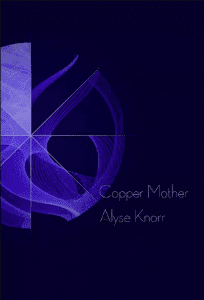Colorado Poet Series: Interview with Alyse Knorr
The local literary scene is, one must remember, a community. (One you can be a part of, by the way, whether you’re a writer or reader!) In fact, after I interviewed the poet Elizabeth Robinson who connected me with fiction writer David Hicks, and it was David Hicks who recommended that I reach out to poet Alyse Knorr.
It was my pleasure to read two of Alyse Knorr’s poetry collections, Copper Mother and Mega-City Redux for the purpose of this interview. These collections of poetry and prose respectively are both delightfully dense and unusual explorations which perpetuate insightful cultural commentary within each of their respective narratives.
First, a little bit about Alyse:
Alyse Knorr is an assistant professor of English at Regis University and editor of Switchback Books. She is the author of the poetry collections Mega-City Redux (Green Mountains Review 2017), Copper Mother (Switchback Books 2016), and Annotated Glass (Furniture Press Books 2013), as well as the non-fiction book Super Mario Bros. 3 (Boss Fight Books 2016) and the poetry chapbooks Epithalamia (Horse Less Press 2015) and Alternates (dancing girl press 2014). Her work has appeared in Alaska Quarterly Review, Denver Quarterly, Columbia Poetry Review, The Greensboro Review, and ZYZZYVA, among others. She received her MFA from George Mason University, where she co-founded Gazing Grain Press.
Now, about Copper Mother (Switchback Books 2016):
 “Through a startling mixture of forms and language, Copper Mother generates an unusual love story—of loving one’s world so tremendously that that world must be shared, at enormous risk and with unprecedented ingenuity and effort. The ‘Friends’ of Knorr’s universe bring their gentle curiosity to human heroics and frailties, and the humans—we humans—are redeemed by our eagerness to share our naked selves and by Jane, who bravely matches the terrors of mortality with a selfless faith in our capacity to love. Sincere even in its playful and fantastic moments, Knorr’s poetics emerges from a deep groove of mourning all that we have to lose and will certainly lose, every day and on the last day, perhaps most of all ‘our mothers, tired/and lovely and floral and gone.’ In that mourning, though, runs an illimitable current of open-hearted reverence that is the best of humanity and beyond its possession—that craving for contact ‘[t]his world wishes across/space’ to whomever might accept our greeting and the belief that we are already together with loved ones, those we’ve lost and those we haven’t yet met, in the slippery fullness of time.”
“Through a startling mixture of forms and language, Copper Mother generates an unusual love story—of loving one’s world so tremendously that that world must be shared, at enormous risk and with unprecedented ingenuity and effort. The ‘Friends’ of Knorr’s universe bring their gentle curiosity to human heroics and frailties, and the humans—we humans—are redeemed by our eagerness to share our naked selves and by Jane, who bravely matches the terrors of mortality with a selfless faith in our capacity to love. Sincere even in its playful and fantastic moments, Knorr’s poetics emerges from a deep groove of mourning all that we have to lose and will certainly lose, every day and on the last day, perhaps most of all ‘our mothers, tired/and lovely and floral and gone.’ In that mourning, though, runs an illimitable current of open-hearted reverence that is the best of humanity and beyond its possession—that craving for contact ‘[t]his world wishes across/space’ to whomever might accept our greeting and the belief that we are already together with loved ones, those we’ve lost and those we haven’t yet met, in the slippery fullness of time.”
– Elizabeth Savage, author of Idylliad
And finally, about Mega-City Redux (Green Mountains Review 2017):
In 1405, Christine de Pizan, the world’s first professional writer, published an allegorical work called The Book of the City of Ladies, in which she imagined constructing (with the help of her fairy godmothers Reason, Rectitude, and Justice) a walled city where women could live safe from sexism, misogyny, and gendered violence. Six hundred years later, we still need such a city. Mega-City Redux charts a road-trip search for this mythical city today, with the help of 21st-century feminist heroes Buffy the Vampire Slayer, Xena Warrior Princess, and Dana Scully from The X-Files. Mega-City Redux is essential architecture built from ‘sword, suit, stake, and pen’ – feminine, marvelous, and mega-tough.”
– Mel Nichols, author of Catalytic Exteriorization Phenomenon
From here, we dialogue:
1. Your most recent projects, Mega-City Redux and Copper Mother inhabit unique worlds while following somewhat strange, utterly unpredictable narratives. How did the seedling ideas for these works germinate into their final works? Can you describe the creative decision-making process which led to their unique content and form?
The idea for Copper Mother came from a Radiolab interview with Ann Druyan in which Ann describes creating the Voyager Golden Record with her late husband, Carl Sagan, in 1977. NASA sent the Record into deep space with the hopes that an extraterrestrial civilization might find it, and it contains images, sounds, and languages from Earth meant to introduce our species to aliens. I started reading more and more about the Record, and started wondering what might happen if aliens did find the Record and come to Earth to talk to us about it. Ann ended up a character in the book as “Jane,” and I imagined that the aliens might have a technology that would allow present-day Jane to converse with her 1977 past-self. I’ve always been a big fan of science fiction, so I had a blast getting to play with some classic sci-fi tropes (like time travel and a moment of “first contact”) in the book.
I wrote Mega-City Redux after reading Christine de Pizan’sThe Book of the City of Ladies, a 1405 allegory in which Christine imagines building a walled city—with the help of her three fairy godmothers Reason, Rectitude, and Justice—where women can live safe from sexism and misogyny. I also wrote the book in the wake of the 2014 Isla Vista shootings, when a man shot and killed several women out of purely misogynistic hate. This violent tragedy made abundantly clear to me that we still need Christine’s City of Ladies today just as much as we did 600 years ago, so I imagined going on a road trip to find the City with my three personal fairy godmothers—Buffy the Vampire Slayer, Xena Warrior Princess, and Dana Scully.
With both of these projects, once I had the premise and the characters in mind, I just wrote as many poems as I could to try and see what would happen. I love to work in the novel-in-verse form because I get to build a world and create characters and then put them into interesting situations just to see what they’ll do. I love when my characters surprise me and when the plot takes a turn I didn’t see coming!
2. How did you arrive at the decision to source the unnamed female narrator’s fearless female companions Dana Scully, Buffy the Vampire Slayer, and Xena Warrior Princess, as companions? How are their popular personas purposed in your work, and what effect does their pre-established backstories have on your work? Why did you choose these characters specifically?
I’m a big TV buff, and TV has always been my outlet for self-exploration and my pathway to self-understanding. When I was a young girl, I couldn’t picture myself as the damsel in distress or the love interest in the media I consumed, but I could imagine myself into the role of hero in the form of a Ninja Turtle or Batman. I only felt ready to come out as a lesbian in graduate school after watching all six seasons of The L Word. And so, I really do consider Buffy, Xena, and Dana to be my feminist heroes or role models—they made a big impact on me when I first watched their shows, and they continue to mean a lot to me today.
At the time I wrote Mega-City Redux, I had also recently read Susan Douglas’s book Enlightened Sexism, which is all about the pop culture feminist TV renaissance of the 1990s-2000s, when shows like Buffy and Xena debuted with their fiercely feminist and also really campy and fun content. Even though Mega-City Redux is about very serious social issues, I wanted to have fun with it, and I loved the idea of spending time on a road trip with these three extremely different women. I loved thinking about how they might interact—how they might annoy each other in the car and how they might care for the other. I really appreciate that they’re all such different types of heroes, which I think is important for feminist dialogue. Dana is my Reason figure—logical and intellectual. Buffy is my Rectitude figure—she tries to set things right, which is an inherently vulnerable act to take. Xena is my Justice figure—she wrestles with the thin line between justice and revenge.
What’s great about these three characters is that they’re already so complex and have so much backstory—Dana Scully is the voice of reason to her partner Fox Mulder, and she’s a very logical, left-brained doctor—but she’s also a person of firm religious faith. This kind of complexity made it easy to work with my characters’ backstories and stay true to them without caricaturing them. But my main goal wasn’t to write about the shows or the characters but rather to take them and plop them into my narrative and go on this quest with them.
3. Mega-City Redux cleverly, humorously combines feminist content with pop culture imparting an accessible, modernized spin. What reader responses have surprised or impressed you? What role do feminist works such as your own play in the current political climate?
I’m always surprised to see just how much these pop culture figures mean to folks. I’ve had readers talk to me about how they first realized they were gay because of Dana or Xena, and I had a reader recently show me a photo of she and her wife dressed up as Xena and Gabrielle (Xena’s beloved) for Halloween. I teach a class on superheroes at Regis, and I love talking with my students about why pop culture matters. TV is often lightyears ahead of the mainstream public discourse, so it can advance social justice movements in powerful ways—shows like Glee and Grey’s Anatomy won a lot of hearts and minds over to the cause of LGBTQIA rights. But TV also acts—just like the Golden Record—as a kind of time capsule snapshot of our world and our culture at this specific moment in time. I love this inherent tension, and I love the space that pop culture creates for “serious play.”
When I read works like Frank O’Hara’s poem “Lana Turner Has Collapsed” or Gary Coleman’s book of superhero poems Missing You, Metropolis, I’m always reminded of the power of writing about our celebrity or our fictional pop culture heroes. These are our modern-day “saints” and icons—our role models and outlets and thought experiments. They can act as a kind of common language through which to discuss the issues of our time, and because they exist in another, imaginative realm, they’re also inherently full of possibility and potential. These, to me, are the ingredients of powerful dialogue.
4. While the majority of science fiction works treat alien arrival as synonymous with the apocalypse, Copper Mother approaches alien arrival with a tone of friendly, casual curiosity. What reason lies behind this significant, divergent decision?
I wrote Copper Mother while I was living in Alaska, and while we were there, my wife and I received many visitors—family and friends who had always wanted to go to Alaska and finally bought their plane tickets after we moved there. So we spent a lot of our time being tour guides—showing our visitors things and places that felt totally ordinary to us but that totally blew their minds (glaciers! moose! bald eagles!). I think for this reason, I imagined a real tenderness between the humans and Our Friends. They often have awkward but always well-meaning, sweet exchanges. The humans sincerely want to be good hosts and Our Friends genuinely want to be polite visitors. I’ve always been interested in what happens when two very different cultures or groups meet and interact, and on what gets included or neglected from the tour or the introductory conversations.
I’m also very invested in the sincerity of the Golden Record project itself—it’s our only truly “species-wide” project—the only artifact we have that attempts to represent us as a unified planet rather than a fractioned collection of different groups. There’s an inherent optimism in the idea of the Record itself—a beautiful hopefulness that I wanted to capture in my book. To launch the Record into space is to believe that someone will find it who wishes us well and wants to connect with us—and that’s the possibility I wanted to envision in my book, not the terrifying (and cliche!) apocalyptic one. I’m a pretty uncynical person by nature, so this was easy for me to imagine.
5. Throughout the work, the aliens, later joined by Then-Jane, communicate through sound effects. How did you go about developing these dialogues?
The Golden Record includes a tremendous amount of sound, including an address by Jimmy Carter, spoken greetings in 55 different languages, a wealth of music (including Beethoven, Chuck Berry, Navajo night chants, and mariachi), and a series of “sounds from Earth” (wind, rain, crickets, wolves howling, cars).
During my research, I learned that many astrobiologists believe that if extraterrestrials ever actually hear the Record, they probably won’t be able to distinguish between the different sounds included—their auditory organs and understanding of language may be so different from ours that they may not know the difference between the music, language, and natural sounds on the Record. For that reason, I wanted Our Friends (and Then-Jane, since she’s a product of the Record) to speak with a mixture of all the types of sounds included on the Record. All of the dialogue they speak comes from actual Record contents, whether it’s a thunderstorm or a hyena laughing or a trumpet wail. I like the way this allows me to play with the definition of “language”—which is something the Record does, too, by including whale song not in the natural sounds portion of the content, but in the languages section!
6. And finally, info on how to purchase both works!
The best way to purchase is to go out to my website, www.alyseknorr.com, and click the licks on the books to go to the publisher’s page.

